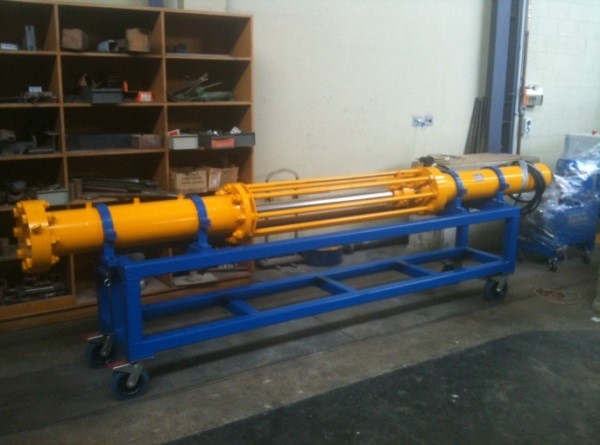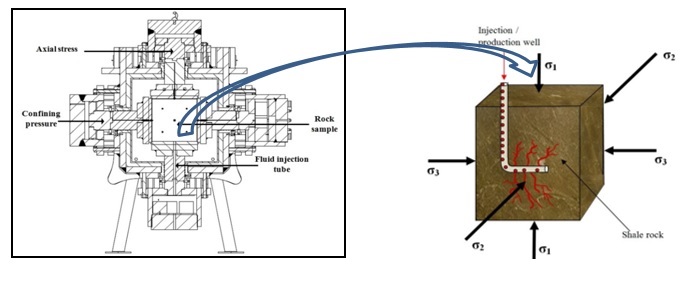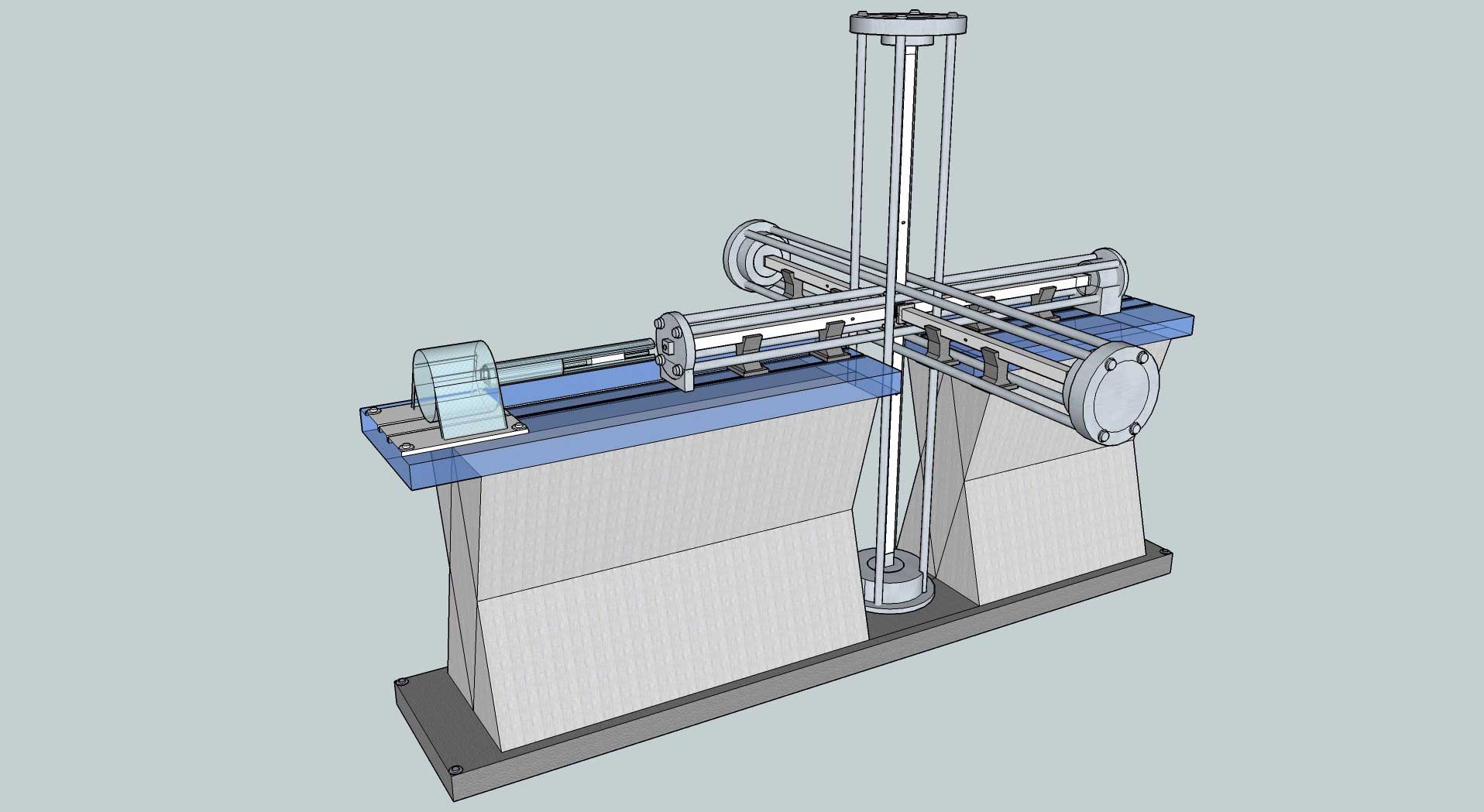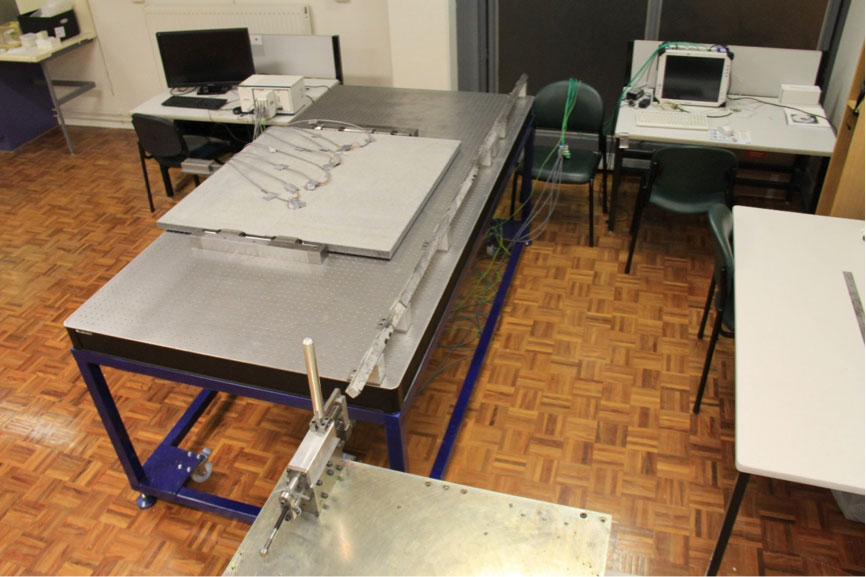These large-scale testing devices permit the use of unconventionally large samples that can carry more complex fracture and cleat network patterns that better represent the discontinuity pathways available in the field for fluid flow in deep coal-seam CO2 sequestration with enhanced methane recovery. Fidelity in laboratory simulation of actual field conditions is thus maximised by use of the large-scale equipment.
Macro scale Triaxial rig
The large-scale advanced testing apparatus, the only apparatus of its kind in Australia, is capable of performing mechanical tests on rock and coal samples up to 500 mm in diameter – up to two orders of magnitude larger in size than those that can be tested using more conventional advanced triaxial setups – by application of deviatoric stress to failure. The device is capable of simulating single- (gas, liquid supercritical fluid) or multi-phase (liquid and gas) fluid flow through the tested sample, using fluid pressures of up to 25 MPa. Confinement pressure can be applied at pressures up to 70 MPa and the cell can be heated to temperatures up to 100 C, to simulate ground conditions (pressure and temperature) at depths in excess of 2.5 km. The large-scale advanced triaxial apparatus is fitted with state-of-the-art controls and measurement equipment to continuously monitor axial load and displacement, confining pressure and radial deformation, cell temperature (gas and liquid) injection pressures and outlet (gas and liquid) flow rates. External measurement equipment, including devices to detect emission of P and S waves and acoustic energy generated by sample deformation during testing (see Ranjith et al. 2004, 2008), are available for use with this large-scale apparatus.
Core flooding apparatus
The large-scale core flooding apparatus, like the large-scale advanced triaxial apparatus is the only apparatus of its kind in Australia and possibly the world. It can perform single- or multi-phase (up to three gas and/or liquid phases simultaneously) fluid flow and sorption tests on samples of soil, rock or coal 200 mm in diameter and 1000 mm in length. Testing involves injection of fluid to the core at pressures up to 25 MPa and observation of pressure and flow rates at the inlet, outlet and three measurement points along the device, that provide an understanding of the nature of variation in pore pressure across the core sample. The outlet pressure can be regulated to investigate the relative pressure drop across the sample at various values of absolute pressure. At each measurement point, manual sampling of the pore gas can be carried out periodically using gas bulbs attached to the port. Gas chromatography carried out on the samples collected will provide information regarding the composition of the various gas phases along the sample. Testing can be carried out at confining pressures up to 32 MPa, applied by an axial load of up to 100 tonnes on a sample constrained by the stainless steel barrel. P and S wave detection devices can be used to track fluid migration through the sample during and following injection.

An Advanced, Macro-scale, hydro-thermo-mechanical Testing Chamber sustainable deep geological applications (ATMC)
The AMTC will add to a set of large-scale, high-pressure testing devices located at MUCEL that were designed to simulate deep geological hydro-mechanical behaviour. The proposed device is unique in capability from the current large-scale devices in the following aspects: (1) sample size; (2) attainable, ground (and tectonic) stresses in three directions; (3) achievable fluid pressure; (4) sample temperature; (5) 3D AE sensing technology, and (6) ability to model complex fluid flow scenarios using large sample size and numerous injection ports. This device permits testing of unconventionally large samples, carrying more intricate pore-and-fracture network patterns to represent more effectively the complex flow pathways in shale gas reservoirs. This stress reactor is capable of testing 750 mm-sided cubic samples, with maximum triaxial stresses (σ1, σ2, and σ3) of 350 MPa at temperatures up to 400 ºC and fluid-injection pressures up to 350 MPa. The equipment has ports to measure the injection pressures, strains, volume changes, temperatures, and pore pressures of different fluid phases. In addition, there are sensors for P (primary) & S (secondary) wave measurements, and acoustic emission (AE) devices to study energy and crack propagation characteristics.

Three dimensionally compressed and monitored Hopkinson bar
The developed 3D Hopkinson bar (3D-HB) system mainly consists of a dynamic loading system, three pairs of high-strength steel bars in three perpendicular directions, a high-pressure triaxial confining loading system, a 24-channel high-speed and high-precision data recorder for data acquisition and information storage, and an ultra-high speed imaging system. The barrel has a bore of 50 mm and a length of 1.5 m, and a striker bar is launched by the gas gun at velocities up to 50 m/s. High-strength steel bars with the cross-sectional area of 50 × 50 mm2 contain the cubic samples.
The planned research on the developed 3D-HB system includes:
- To quantitatively determine mechanical properties of brittle materials under dynamic loads, focusing on rate-dependent constitutive models and fracture criteria.
- Dynamic fracturing/fragmentation of brittle materials caused by blast and impact loading, mechanised excavation, and pulsed-water hydraulic mining.
- Stress wave transmission and attenuation across material joints, and the effects of geometrical and physical properties of joints and filling materials.
- Energy and wave transmission during dynamic fracturing related to earthquake, deep mining, blasting and explosion, protective structure design.

Seismic Experimental Platform for Rock Joints
The seismic experimental platform (SEP) is available for the investigation on the seismic response of rock fractures. A high bearing capability table (2.4m×1.2m) possessing an extremely surface with equally spaced (25mm) screw holes is used as the basement, on which several basic components are free combined, including: 1) the spring loading system which can generate different types of stress waves; 2) the static loading cell system which can provide confinement in all directions; 3) the low frictional supports with different shapes for rock bars or rock plates; 4) the lateral baffles used for the fix or guidance of the rock plate movement; 5) rock bars and plates of various size used as the wave propagation medium and fracture container. The high-speed data acquisition is realized through two synchronized HBM Gen3i and Gen7i system with 40 channels and 1MHz sampling frequency.
The current applications including:
- A split Hopkinson rock bar used to simulate 1D P-wave propagation across a single rock fracture or a set of parallel rock fractures.
- A dynamic-induced direct-shear model used to investigate dynamic triggering of frictional slip of a rock fracture, which uses a 2D P-wave as a shear stress.
- An unload-induced direct-shear model is designed to perform frictional failure of a rock fracture induced by a combination of a decreasing normal stress and a constant shear stress.
- A equal-width impact model used to investigate obliquely incident plane P-wave propagation across welded or non-welded rock fractures.

